Sea rivalry of England and Holland. Third war. Battle of Texel
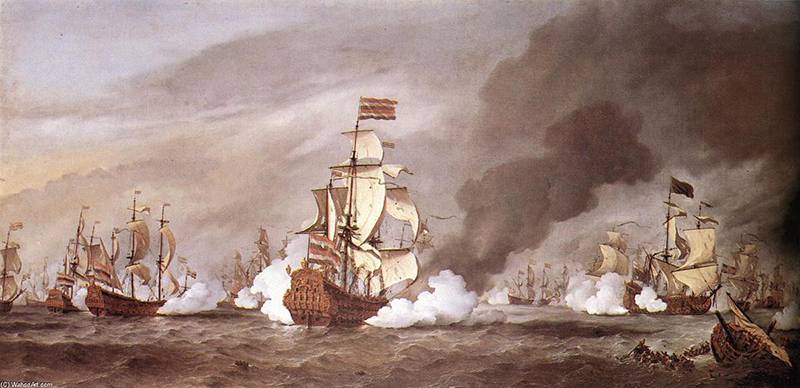
When the parties to the conflict sign a contract, painfully trying to impart at least some semblance of a polite smile to their tightly compressed lips, while the gnashing of teeth clearly drowns out the creaking of their feathers, it becomes obvious: the dot in the text is by default the comma. England and Holland, having signed peace among themselves in Breda, clearly realized this. Both countries, competing for a place under the European, and most importantly, under the tropical sun, barely catching their breath, began to prepare for new clarifications of relations. Moreover, there was every reason to believe that this process will now affect not only the sea, but also land.
Versailles Wind of Change
England was not satisfied with the course of the second Anglo-Dutch war, with majestic gestures neatly covering the ever-increasing number of patches and barely darned holes in the battered financial "camisole". The budget deficit was large - sailors fleet His Majesties received payment by bills, which in shops, taverns and other institutions were taken with great care and much lower than the numbers indicated in them. The powerful clearly saw the way out of the current economic impasse in the intensification of colonial expansion, the expansion of maritime trade, which automatically again implied a full-fledged attack on Dutch interests around the world. Based on the experience of battles with the Dutch, the British were convinced of the correct choice of a fleet formation strategy. The navy should be a separate structure, well equipped and conducting training and exercises in peacetime. The involvement of mobilized merchant ships in military operations was a forced measure and generally did not justify itself.
Suddenly, a new foreign policy factor intervened in the Anglo-Dutch rivalry. France, traditionally loyal to the Netherlands, has changed its mood. In 1661, the successor of the policy of the great Richelieu, Cardinal Mazarin, died, and the young Louis XIV felt the opportunity to manage his own kingdom on his own. The main purpose of his policy, he made the expansion of the borders of France. Considering himself to continue the work of the great cardinal, the young king relied on a well-armed army, gold, and intricate intrigues to carry out his plans. However, before the skill of Richelieu, he was far away.
In 1668, the Aachen peace ended the Devolutionary War between France and Spain over the Spaniards-owned Southern Netherlands. The well-trained French army inflicted a series of defeats on its adversary, but the Dutch intervened in the conflict at the diplomatic level, offering Spain their mediation in signing peace. The fact is that in the Netherlands they preferred to border with increasingly weaker Spain - such a neighborhood seemed more peaceful and, therefore, advantageous. Otherwise, the border would have to be divided with the state, which was ruled by a young and aggressive king.
In January, 1668, a defensive alliance was formed between the Netherlands, England and Sweden, giving an ultimatum to Louis XIV to limit their appetites in Flanders. Faced with the threat of expanding the war, Versailles went to sign peace with Spain. Formally, France was the winner, occupying a number of key fortresses in the Spanish possessions. In fact, the king and his entourage were furious because of the “treachery” of the Dutch, who encroached on the restriction of French expansion. From that moment on, Louis XIV regarded the Netherlands as one of his main opponents.
Perhaps, having embarked on crushing its northern neighbor, France made a big, if not fatal mistake. Nothing prevented the development of France as a great maritime and colonial power in the last quarter of the seventeenth century. Spain rapidly dimmed, the hands of the two maritime powers, England and Holland, were bound by military and economic opposition. The French fleet increased and crepe, developed maritime trade. The German philosopher Leibniz wrote a lengthy note to Louis XIV, known as the “Egyptian Project”. In it, he called on the king to create a powerful colonial empire and pointed out the need for France to seize Egypt and create strongholds in the Mediterranean and Red Seas. The control over Egypt dealt a severe blow to the power of the Ottoman Empire and handed over to the French trade with the East, and therefore wealth and power. According to Leibniz, the seizure of Egypt was much easier and, most importantly, a more promising military enterprise than the struggle against Holland. “Holland will be conquered in Egypt,” the scientist wrote to the French king. However, Louis XIV did not change the course of his European policy.
Mindful of the superiority of the Dutch at sea, the French king decided to secure the support of the king of English - Europe before and after, knew this amazing ease of entering into and dissolving all kinds of alliances. Charles II needed the main, most important and fundamental resource for a more dynamic development of foreign policy - in money. And Louis could provide this resource to London. The brilliant policy of the Minister and the de facto head of the government of Colbert allowed France to invest heavily in foreign policy projects.
In May 1670, the wife of the brother of the French king Henrietta d'Orleans arrived in England on a “goodwill” mission, equipped for its successful implementation with a large number of specie coins. Knowing the fascination of Charles II with the beautiful half of humanity, to speed up the process, he was introduced to a certain Mademoiselle de Cerual, and after a couple of weeks of in-depth acquaintance with the intricacies of French culture, generously seasoned with full-bodied pistols, the king signed an alliance agreement with France. Mademoiselle was also not forgotten by Charles: she was transported to London and, for convenience, awarded the title of Duchess of Portsmouth. Soon the English embassy went to France to discuss directly the set of actions against Holland directly.
Relations between rival maritime powers, which were already formerly not friendly, began to heat up gradually. At sea, there were several misunderstandings associated with saluting salutes. A glaring incident happened to the English yacht Merlin, which, threatening to open fire, demanded a salute from the Dutch squadron standing in its own waters. To the credit of commander van Ghent, he vowed to sink the impudent British, if he dares to make a shot at his ships. At the start of the 1672 of the year, England sent diplomatic channels through the Netherlands to a wish more like an ultimatum. The Dutch were offered to salute the smallest English ship now — even on the Dutch coast proper. In response to such arrogance, clearly turning into an insult, the General States, the Parliament of the Netherlands, are beginning to take measures that would have been worth taking for a long time.
Parties are preparing
Representatives of the commercial and industrial strata of the United Provinces on the eve of the third war with England simply had to understand that all of their vast, smelled aromas of oriental spices colonial economy needed constant protection. And that this requires a regular fleet and appropriate funding. The powers that be, not alien thrift, of course, frowned, looking at the estimates and bills, but put their signatures. Overly stingy and thrifty could lose everything. Beginning with 1668, the Dutch fleet conducted regular summer exercises every summer, perfecting linear tactics and evolution. Separately, and even in winter, exercises for gunners were carried out - the emphasis was placed not only on the accuracy of the defeat, but also on the speed of loading. By the beginning of the war, the Dutch fleet had 75 ships (battleships and frigates). However, not all of them were fully equipped and equipped.
The English fleet, like any complex organization experiencing the financial crisis of its country, could put up around 80 ships and frigates. Some of them had a shortage of personnel: the parliament, which in general did not support the king’s insistent idea of fighting the Dutch, and even in alliance with France, allocated money extremely sparingly and reluctantly.
The French fleet experienced rapid growth at this time. In the 1661 year, at the start of Colbert's activity, France had no more than 30 warships, of which only three had more than 30 guns. After five years of his work, this number increased to 70. By 1671, the French fleet had almost 200 ships, 107 of which had weapons from 24 to 120 guns. The work went in an integrated manner: simultaneously with shipbuilding programs, arsenals, warehouses and shipyards were built. Brest and Toulon became the largest and well-fortified naval bases. Moreover, the French large-tonnage battleships were so good that the British began to adopt their design.
However, if with the technical side everything was more or less well, then the personnel issue was extremely acute. At first, the serving nobility was not seduced by the prospects of the maritime service, and it had to be lured into the navy primarily financially. With the lower ranks it was even worse - the teams had to be recruited by voluntary-forced recruitment, systematically catching vagrants on the roads and in the port courgettes. Often the crews were generously diluted with soldiers. All these problems with an impressive list of staff allowed to have no more than 30 combat-ready ships by the beginning of the war.
Start. Battle of Salbey
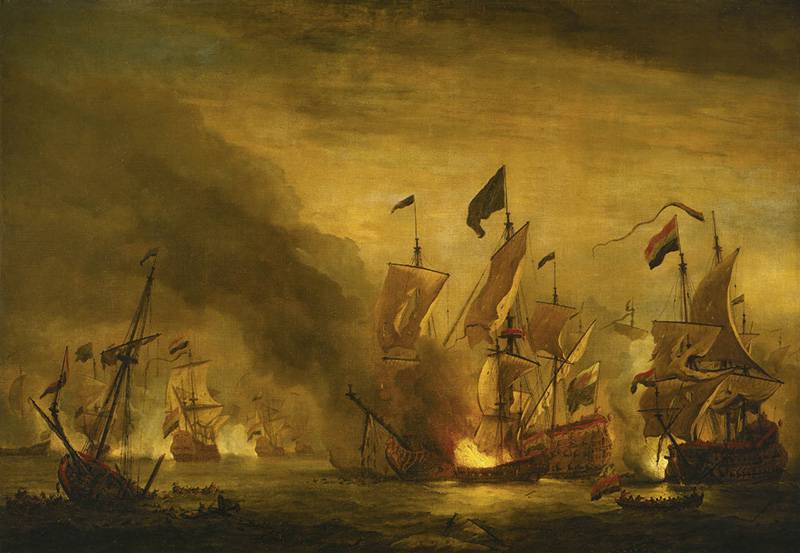
The fighting, as expected, began even before the declaration of war. In March, 1672, admiral Robert Holmes, already known for his African adventures, carried out a direct order from Charles II, attacked a Dutch convoy heading from Smyrna. He, believing that hostilities are almost inevitable, decided not to miss the chance to seize more booty and improve the financial condition of his country. Fighting on parallel courses lasted almost two days and, if we consider that superiority was on the side of the British (6 of the battleships and 2 of the frigate against the 5 of the Dutch frigates), it ended unsuccessfully for them. Holmes managed to beat off only 4 from commercial ships 72. In fact, it was an act of banal sea robbery, carried out at the state level.
29 March 1672 England announced that it would start fighting against the Netherlands from 7 April - on that day France was to declare its intention to go to war. Participate in the conflict on the side of the Anglo-French small bishops of Cologne and Munster, who had their own mini-armies, contracted. The Dutch plan was simple enough: defeat the English fleet before it was merged with the French. Despite the impressive payroll, the equipment of the Dutch fleet also left much to be desired. And thanks to this factor, as well as not very favorable weather, de Ruyter was able to go to sea only on May 10. 15 May he learned that the English and French fleets were united around the Isle of Wight, - the Dutch were late.
It should be noted that the Dutch fleet was attended by high authorities in the person of the great pensioner of the province of Holland and the de facto head of state, Jan de Witt. The temptation of a person of such a high rank to give valuable advice, more similar to orders, did not pass him. De Witt insistently demanded a trip to the Thames for the purpose of sabotage. Ruiter yielded, and the Dutch fleet 23 May anchored at the mouth of the largest English river. But the British were already taught by bitter experience, and the banks up the Thames were heavily fortified. Not having achieved any intelligible result, the Dutch were forced to return to their shores.
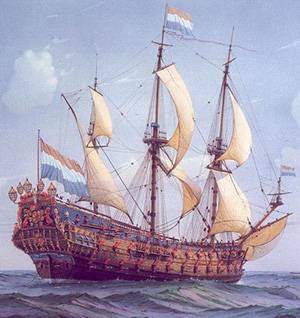
The end of May and the beginning of June were spent in search of the enemy, until, finally, on June 6, an allied fleet under the command of the Duke of York was found in Solbey. The balance of power was as follows. 45 English and 26 French ships and frigates, 35 ships of other classes and transports, 24 brander. In total more than 5 thousand guns and 33 thousand crew. They were opposed by the 61 Dutch ship with the number of guns over 40, the 22 ship of the smaller classes and the 36 firewalls - 4500 guns in total and 21 thousand people. The Duke of York held the flag on the 120-gun "Royal Prince", the commander of the French squadron Count d'Estre was on the 78-gun "Saint-Philip". In fact, by agreement between the two states, all the leading positions in the fleet remained with the British, as more experienced in the maritime business. De Ruyter's flagship was the 80-gun "De Zeven Provinsien".
The Allied fleet was at anchor, the English flagship was being prepared for pitching, and numerous freshwater boats were sent to the shore. In the midst of such a measured rear life, the French frigate “Eol”, on patrol, reported the approach of the enemy fleet. The emergency turmoil began: the teams were returning from the shore, the boats were raised, the sails were set. Soon the leader of his ships appeared in the formation of the front de Ruyter. Unfortunately for the Dutch, the wind began to subside, which prevented the Allies from being taken by surprise. The Anglo-French fleet was divided due to the unsuccessful maneuver d'Estre, and at 7 on the morning of 7 on June 1672, the Dutch opened fire.
The battle was reduced to a lengthy and exhausting mutual cannonade. "De Zeven Provinsien" led a nearly two-hour firefight with the flagship of the Duke of York "Royal Prince". The well-trained Dutch gunners fired noticeably better than their English counterparts, and the duke had to transfer his flag to St. Michael. The Royal Prince lost the mainmast, numerous holes gapeled in its hull, and in the end it was towed by boats over the line of fire. During this encounter on the deck of “De Zeven Provincien”, Jan de Witt was serenely seated, surrounded by the guard of honor from the 12 of the aleberard. Five of them were struck down, but the great pensioner remained unharmed. The battle lasted all day and subsided at nightfall.
Both sides had a lot of damaged ships - the Duke of York was forced to once again change his flagship, de Ruyter also transferred his flag from the heavily damaged "De Zeven Provinsien", which released a total of more than 3,5 thousands of cores. In the battle of Solbey, the allies lost 4 ships and 2500 people, the Dutch lost 2 ships and about 2 thousands of people. De Ruyter maneuvered for two more days in view of the allied fleet and on June 9 departed to his native shores, not pursued by the enemy. Both sides declared their victory, but the arguments of the Dutch were more convincing. The landing of the Allies on the Dutch coast was disrupted, their ships were in a more deplorable state, no attempt was made to prosecute.
French invasion
14 May 1673, an almost 120 thousandth French army invaded Flanders. It was led by Marshal de Turenne, Prince de Conde and Louis XIV himself. The Dutch could oppose these hordes with no more than 25 thousand mercenaries, mostly German. One by one, the French occupied the cities and fortresses — Maastricht, who remained deep in the rear, put up persistent resistance. In late June, Turenn reached the distant approaches to Amsterdam.
Panic began in the city. A deputation was sent to Louis with a peace proposal: the Dutch were ready to give a number of fortresses and pay 6 millions of guilder contributions. The party of “constructive dialogue” and “partnerships” with France, led by the brothers de Witts, are ready to make even greater concessions, if only they would not lose all their fortune. Fortunately for the Dutch, the French king, quite confident in his abilities, demanded a completely unthinkable for the merchants figures in 25 million guilders and the assignment of almost half of the territory of the Netherlands. To the panic in Amsterdam began to mix the horror of the awareness of the situation.
During the war with the aggressor, only Wilhelm of Orange and his colleagues acted. Their calls for resistance found a wide response from the common people. The selective detachment of German mercenaries managed to regain control of the strategically important fort Muyden, located at the intersection of several rivers, and open dams. The water flooded a large area, actually slowing down the French offensive. In late July, a revolt broke out in a number of large cities, and William of Orange came to power in his wake. The de Witt brothers were arrested and imprisoned.
Two factors saved the Netherlands in 1672 and were decisive for the further course of the war: the victory of de Ruyter under Solbey and the return of Muyden with the subsequent coming to power of the Oransky party, which was made a lifelong shtgalter. Louis XIV, having lost the fat bird from the hands in the hope of catching the ghostly crane, lost interest in the company and returned to Paris with frustrated feelings. The international situation in Europe for France began to deteriorate - seeing the young French monarch's tendency toward military adventures, a number of states, primarily Brandenburg, the Holy Roman Empire, Spain and Denmark, began to express ever-increasing concern.
Airborne Prevention and Texel
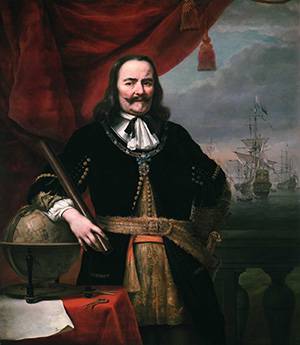
After wandering around the rest of June and July 1672, off the Dutch coast, the Allied fleet did not decide on landing operations and eventually dispersed to the bases. For De Ruyter, this was a great relief, since the arrival of William of Orange redirected the flow of resources from the fleet to the army. Part of the crews, mostly gunners, was also transferred to the ground forces. Nevertheless, there was no doubt that in the new 1673, the Anglo-French would again try to land on the Dutch coast, since access from the continent was blocked by flooding part of the territory. Taking advantage of the complete passivity of the Allies, a large East Indies convoy arrived in the Netherlands, thanks to which resources for the further waging of war appeared. The fleet was funded, and 1673 planned to equip 48 battleships, 12 frigates and 24 firefighters. However, these forces did not seem enough to the Dutch command, and it was decided to further prepare another 24 ship and 12 frigates. In May, de Ruyter went to sea, having orders to make a demonstration at the Thames and, if possible, take the enemy off guard. Bad weather conditions prevented the implementation of these plans.
The British had personnel changes. The Duke of York was removed from command due to his Catholic religion and replaced by Prince Rupert, a relative and close associate of the executed Charles I. The Joint Allied fleet had a 81 battleship, 11 frigates and more than 30 branders. To this number you can add the 27 French ships. At Yarmouth 6-thousandth landing squad prepared for loading. De Ruyter, who took positions behind the Shoneveldian shoals, had under the command of 52 battleships, 12 frigates, 14 smaller ships and 25 firefighters - 3600 guns and 18 thousand crew members.
There was an interesting situation: the stronger Allied fleet was inactive and did not dare to attack the Dutch, because it did not have pilots who knew the hydrography of this region. It was necessary to undertake something, since time obviously worked for the Dutch. Prince Rupert had an idea to drag De Ruyter into battle with the help of shallow ships, to lure him to deep water, where the entire allied fleet had to enter into the business. The attack was scheduled for 7 June, the anniversary of the battle of Solbey. The 12 of the British and 9 of the French battleships were singled out as the “lure group”. The Allies attacked in disarray, and they soon retreated without causing much damage to the enemy. Moreover, with their retreat they violated Rupert’s own structure.
The Dutch raised their anchors and successfully counterattacked. The commander of the avant-garde, the irresistible Cornelis Tromp attacked on his own allies, despite the difference in strength. De Ruyter even had to send an order on a high-speed yacht in order not to let the Trompus ruber get bogged down in battle against superior forces. However, the order reached him too late. De Ruyter and the commander of the rearguard Bambert also entered the battle. And Rupert’s plan seemed to be a success, and the Dutch fleet took the fight, but the construction of the allied fleet was in an unsatisfactory condition and prevented the use of numerical superiority.
De Ruyter attacked the French squadron d'Estre with the main forces, considering it to be a weak link in the enemy’s fleet, and soon brought it into complete confusion, although it was not possible to build on the success and defeat the French - de Ryuiter had to rescue Bankert, whose system was mixed. Having regained the situation, the Dutch went to the aid of the zealous Trompa, who had already transferred his flag from the 82-gun "Guden Leuf" tormented by the English cores to another ship. De Ruyter appeared when the position of the Dutch avant-garde was almost critical. Tromp is credited with this expression with a feeling: “Our old man (de Ruyter’s nickname in the navy) comes to our aid!” Reunited with the vanguard, the Dutch fleet went to the coast to its former sites. The Allies dropped anchors in 12 miles more seaward. Both sides had losses in people of about 400 – 500 people, many ships were damaged.
Although Rupert was able to entice Tromp and then the entire fleet into battle, the allies did not receive much benefit from this. The Dutch kept the initiative throughout the battle, more skillfully maneuvered and fired. De Ruyter once again succeeded in disrupting the attempt to land on the territory of the Netherlands, keeping at his distance from the coast the superior forces of the enemy. Both sides remained combat-ready after the battle, but the proximity of de Ruyter to their bases with their resources allowed them to quickly repair the most damaged ships.
14 June 1673, the allied fleet made a new attempt to attack the Dutch, but it all came down to an intense exchange of fire at long and medium distances - only Tromp moved close to the enemy. With the onset of darkness, the second battle at Shoneveveld subsided by itself. The parties lost from 200 to 300 people killed and wounded. Damage was minor. The coast of Holland remained unreachable for Rupert. 15 June his fleet went to the Thames.
The morale in the Dutch fleet was high — their scouts reached the English coast and found the allied fleet taking refuge in the Thames. Throughout the first decade of July, de Ruyter cruised in the sight of the British, dispelling rumors of the alleged cowardice of the Dutch and their unwillingness to move far from Amsterdam. The outbreak of smallpox on ships forced de Ruyter to return and hand over the sick. And on July 28, information was received that the Allies had gone to sea.
The British had great difficulties in assembling ships with crews: recruiting teams diligently trotted out inns and shelters - the war was becoming increasingly unpopular. Prince Rupert brought the 90 battleships (of which 30 were French), 4 frigates, 30 firefighters and 25 transports. De Ruyter immediately went to sea, but for some time he could not find the enemy. 4 August allies anchored off Texel. 8 August, having received information about the location of Rupert, the Dutch fleet took its usual place from the Shoneveld shallows, awaiting instructions. On the one hand, there were a lot of allies to pounce on them first, on the other, the arrival of a large East Indies convoy, which was of vital importance to the Netherlands, was expected soon. On August 12, William of Orange arrived on board the De Zeven Provinsienn 12, who personally asked de Ruyter to attack the enemy at a military council in order to derail him, apparently, the last attempt to land on the coast of the East India convoy.
The Allies remained inactive, and Rupert asked the king for further action: return to Yarmouth for the landing force, search for a convoy, or attack de Ruyter. The king's answer brought the English admirals into a state of a stupor - Charles II ordered the troops not to take aboard, smash de Ruyter, but not the first to join the battle. While the English commander concentratedly scratched his head, not knowing how to execute mutually exclusive orders, the Dutch 20 August withdrew anchors and, preparing for battle, began to converge.
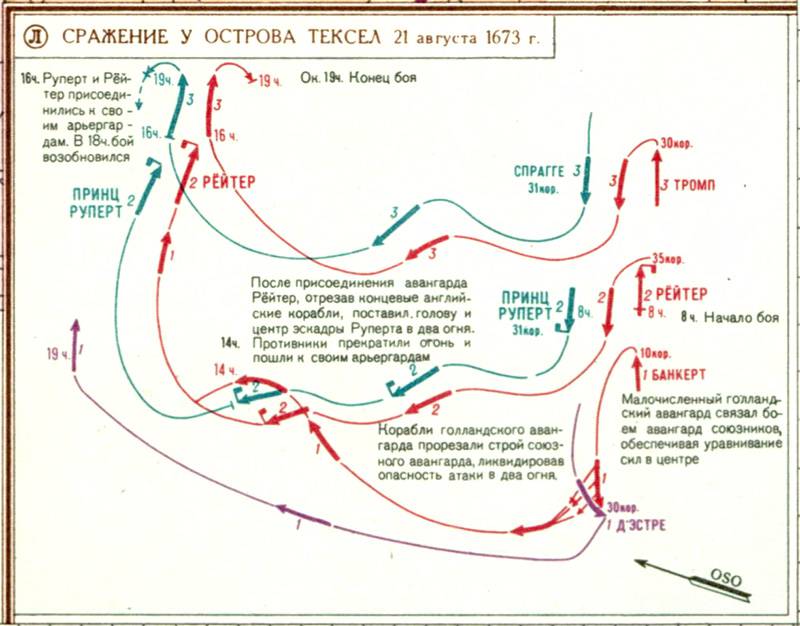
Thanks to the excellent knowledge of the features of local currents, the fleet of the Netherlands, maneuvering at night, in the morning of August 21 went to the allies. De Ruyter had 60 ships and 15 frigates. The Dutch confidently approached the enemy. Both sides were well acquainted with each other: the commander of the vanguard Bambert fought against d'Estre, de Ruyter against Rupert, and the hot Tromp was put on the rearguard to fight Sprague. The fight began at 8 in the morning and by the time 9 was already boiling all over the line. The French admiral tried to put the Dutch avant-garde in two flames, but the more experienced Bangert guessed this maneuver, lowered himself to the wind and, breaking through the poorly closed French line, went to join the main forces. Instead of helping Rupert d'Estre, he began fixing the damage almost to the very end of the battle, which earned him great displeasure from his English colleagues. Rupert, meanwhile, was trying to distract his formidable enemy away from the coast, and therefore the battle of the main forces took place at an average distance.
With the advent of the avant-garde Bunkert de Ryuiter managed to achieve numerical superiority (42 ship against 30) and put the end battleships of the enemy line in two fires. With great losses and damage, the British managed to get out of this dangerous situation. At about 2 hours of the day both commanders went to help their rearguards, where Sprague, who personally hates Tromp and gave the king a promise to take him dead or alive, or to die himself, tried to fulfill his oath. The clarification of the relationship between the two admirals proceeded on such elevated tones that both soon had to change their heavily damaged flagship ships. During the secondary change of the flag, the Dutch core landed in the Sprague boat and sent it to the bottom along with the commander of the rearguard. So the second part of the promise Sprague still fulfilled. The position of the English rearguard was almost critical when Rupert approached him. De Ruyter connected with Tromp, and the battle broke out with a new force.
The onset of darkness stopped the battle - the Dutch moved to Texel, and the Allies headed for England. The losses of the parties amounted to more than 2 thousand people from the allies, and about a thousand from the Dutch. No one disputed the title of the winner at de Ruyter - the last attempt to land the landing ended in complete failure, and soon the East Indies convoy arrived safely in the Netherlands. The significance of the victory at Texel was difficult to overestimate - in many respects it served as the final argument that inclined the English Parliament to the decision to end the unsuccessful and little-popular war in the country.
19 February 1674 was signed by the Westminster World, according to which Holland recognizes the predominance of England at sea. The water area between Cape Finisterre and Norway was now considered the inland English waters, where even the smallest ship under the flag of St. George was supposed to be the first to salute. Holland provided trade privileges to the British in the East Indies and paid indemnities. The conditions so difficult for Holland were dictated by the fact that she needed peace with England. The French army was on Dutch soil. The war with Louis XIV, which soon became a coalition, continued for another four years. France, abandoning the strategically important foreign policy goals set forth by Leibniz, entered the line of exhausting and costly wars, being opposed by most European countries. Her sea power gradually faded away and degraded - an unwise adventure against Holland left, in the end, golden lilies to be torn apart by the British lion.
Information